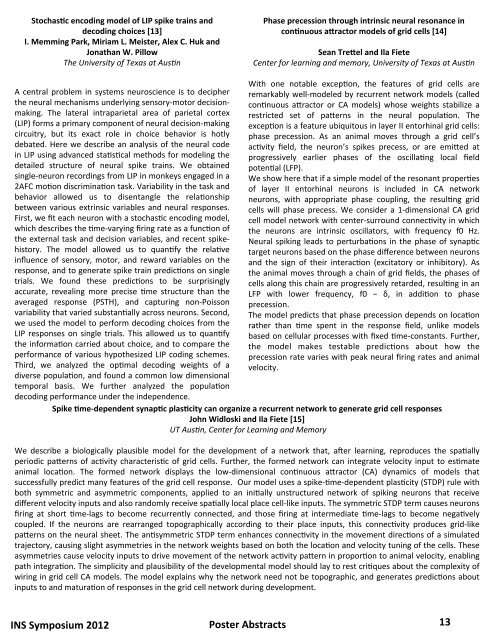Program - The Institute for Neuroscience - The University of Texas at ...
Program - The Institute for Neuroscience - The University of Texas at ...
Program - The Institute for Neuroscience - The University of Texas at ...
Create successful ePaper yourself
Turn your PDF publications into a flip-book with our unique Google optimized e-Paper software.
StochasYc encoding model <strong>of</strong> LIP spike trains and<br />
decoding choices [13]<br />
I. Memming Park, Miriam L. Meister, Alex C. Huk and<br />
Jon<strong>at</strong>han W. Pillow<br />
<strong>The</strong> <strong>University</strong> <strong>of</strong> <strong>Texas</strong> <strong>at</strong> Aus5n<br />
A central problem in systems neuroscience is to decipher<br />
the neural mechanisms underlying sensory-‐motor decision-‐<br />
making. <strong>The</strong> l<strong>at</strong>eral intraparietal area <strong>of</strong> parietal cortex<br />
(LIP) <strong>for</strong>ms a primary component <strong>of</strong> neural decision-‐making<br />
circuitry, but its exact role in choice behavior is hotly<br />
deb<strong>at</strong>ed. Here we describe an analysis <strong>of</strong> the neural code<br />
in LIP using advanced sta8s8cal methods <strong>for</strong> modeling the<br />
detailed structure <strong>of</strong> neural spike trains. We obtained<br />
single-‐neuron recordings from LIP in monkeys engaged in a<br />
2AFC mo8on discrimina8on task. Variability in the task and<br />
behavior allowed us to disentangle the rela8onship<br />
between various extrinsic variables and neural responses.<br />
First, we fit each neuron with a stochas8c encoding model,<br />
which describes the 8me-‐varying firing r<strong>at</strong>e as a func8on <strong>of</strong><br />
the external task and decision variables, and recent spike-‐<br />
history. <strong>The</strong> model allowed us to quan8fy the rela8ve<br />
influence <strong>of</strong> sensory, motor, and reward variables on the<br />
response, and to gener<strong>at</strong>e spike train predic8ons on single<br />
trials. We found these predic8ons to be surprisingly<br />
accur<strong>at</strong>e, revealing more precise 8me structure than the<br />
averaged response (PSTH), and capturing non-‐Poisson<br />
variability th<strong>at</strong> varied substan8ally across neurons. Second,<br />
we used the model to per<strong>for</strong>m decoding choices from the<br />
LIP responses on single trials. This allowed us to quan8fy<br />
the in<strong>for</strong>ma8on carried about choice, and to compare the<br />
per<strong>for</strong>mance <strong>of</strong> various hypothesized LIP coding schemes.<br />
Third, we analyzed the op8mal decoding weights <strong>of</strong> a<br />
diverse popula8on, and found a common low dimensional<br />
temporal basis. We further analyzed the popula8on<br />
decoding per<strong>for</strong>mance under the independence.<br />
Phase precession through intrinsic neural resonance in<br />
conYnuous acractor models <strong>of</strong> grid cells [14]<br />
Sean Trecel and Ila Fiete<br />
Center <strong>for</strong> learning and memory, <strong>University</strong> <strong>of</strong> <strong>Texas</strong> <strong>at</strong> Aus5n<br />
With one notable excep8on, the fe<strong>at</strong>ures <strong>of</strong> grid cells are<br />
remarkably well-‐modeled by recurrent network models (called<br />
con8nuous aEractor or CA models) whose weights stabilize a<br />
restricted set <strong>of</strong> paEerns in the neural popula8on. <strong>The</strong><br />
excep8on is a fe<strong>at</strong>ure ubiquitous in layer II entorhinal grid cells:<br />
phase precession. As an animal moves through a grid cell’s<br />
ac8vity field, the neuron’s spikes precess, or are emiEed <strong>at</strong><br />
progressively earlier phases <strong>of</strong> the oscilla8ng local field<br />
poten8al (LFP).<br />
We show here th<strong>at</strong> if a simple model <strong>of</strong> the resonant proper8es<br />
<strong>of</strong> layer II entorhinal neurons is included in CA network<br />
neurons, with appropri<strong>at</strong>e phase coupling, the resul8ng grid<br />
cells will phase precess. We consider a 1-‐dimensional CA grid<br />
cell model network with center-‐surround connec8vity in which<br />
the neurons are intrinsic oscill<strong>at</strong>ors, with frequency f0 Hz.<br />
Neural spiking leads to perturba8ons in the phase <strong>of</strong> synap8c<br />
target neurons based on the phase difference between neurons<br />
and the sign <strong>of</strong> their interac8on (excit<strong>at</strong>ory or inhibitory). As<br />
the animal moves through a chain <strong>of</strong> grid fields, the phases <strong>of</strong><br />
cells along this chain are progressively retarded, resul8ng in an<br />
LFP with lower frequency, f0 − δ, in addi8on to phase<br />
precession.<br />
<strong>The</strong> model predicts th<strong>at</strong> phase precession depends on loca8on<br />
r<strong>at</strong>her than 8me spent in the response field, unlike models<br />
based on cellular processes with fixed 8me-‐constants. Further,<br />
the model makes testable predic8ons about how the<br />
precession r<strong>at</strong>e varies with peak neural firing r<strong>at</strong>es and animal<br />
velocity.<br />
Spike Yme-‐dependent synapYc plasYcity can organize a recurrent network to gener<strong>at</strong>e grid cell responses<br />
John Widloski and Ila Fiete [15]<br />
UT Aus5n, Center <strong>for</strong> Learning and Memory<br />
We describe a biologically plausible model <strong>for</strong> the development <strong>of</strong> a network th<strong>at</strong>, aBer learning, reproduces the spa8ally<br />
periodic paEerns <strong>of</strong> ac8vity characteris8c <strong>of</strong> grid cells. Further, the <strong>for</strong>med network can integr<strong>at</strong>e velocity input to es8m<strong>at</strong>e<br />
animal loca8on. <strong>The</strong> <strong>for</strong>med network displays the low-‐dimensional con8nuous aEractor (CA) dynamics <strong>of</strong> models th<strong>at</strong><br />
successfully predict many fe<strong>at</strong>ures <strong>of</strong> the grid cell response. Our model uses a spike-‐8me-‐dependent plas8city (STDP) rule with<br />
both symmetric and asymmetric components, applied to an ini8ally unstructured network <strong>of</strong> spiking neurons th<strong>at</strong> receive<br />
different velocity inputs and also randomly receive spa8ally local place cell-‐like inputs. <strong>The</strong> symmetric STDP term causes neurons<br />
firing <strong>at</strong> short 8me-‐lags to become recurrently connected, and those firing <strong>at</strong> intermedi<strong>at</strong>e 8me-‐lags to become nega8vely<br />
coupled. If the neurons are rearranged topographically according to their place inputs, this connec8vity produces grid-‐like<br />
paEerns on the neural sheet. <strong>The</strong> an8symmetric STDP term enhances connec8vity in the movement direc8ons <strong>of</strong> a simul<strong>at</strong>ed<br />
trajectory, causing slight asymmetries in the network weights based on both the loca8on and velocity tuning <strong>of</strong> the cells. <strong>The</strong>se<br />
asymmetries cause velocity inputs to drive movement <strong>of</strong> the network ac8vity paEern in propor8on to animal velocity, enabling<br />
p<strong>at</strong>h integra8on. <strong>The</strong> simplicity and plausibility <strong>of</strong> the developmental model should lay to rest cri8ques about the complexity <strong>of</strong><br />
wiring in grid cell CA models. <strong>The</strong> model explains why the network need not be topographic, and gener<strong>at</strong>es predic8ons about<br />
inputs to and m<strong>at</strong>ura8on <strong>of</strong> responses in the grid cell network during development.<br />
INS Symposium 2012<br />
Poster Abstracts<br />
13


